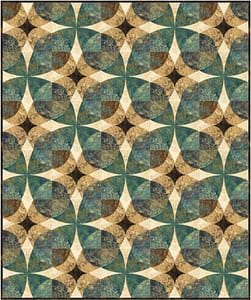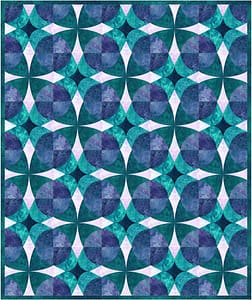CuFe, what an odd name for a pattern. Is it from another language? If so, what does it mean?
CuFe does come from another language that my geeky friends may recognize. It comes from the language of chemistry. Cu is for Copper and Fe is for Iron. Ok – why pick these two metals for a pattern name?
The first pattern was designed with Northcott’s Stonehenge Gradations in the natural colorway. The color were based on the mixed earth oxides. Oxides are basically the rust or bloom formed when a metal reacts with air. Bright orange copper turns green or verde gris when it oxidizes. While grey iron turns red or rust when it oxidizes. So CuFe represents the oxidized metal colors in the fabric. Can you see it now? (Yes – I am a bit of geek…. I am chemical engineer after all. So how does a chemical engineer become a pattern designer. That is a fun story, which I will tell another day. Suffice it to say, that I LOVE puzzles. Pattern designing allows me to make my own puzzles. As an engineer, I want those puzzles to be as easy to construct as possible.)
Not everyone likes neutrals. Some people thrive on color. (One could say that is an accurate description of me.) So a second colorway was created for the bright color lovers. This one uses bright purples and greens. If you are interested in other possible colorways, please contact me and I would be glad to help. The Stonehenge Gradation has so many lovely possibilities!
What else is special about this pattern? The secondary design is what makes this pattern so intriguing. The two block, by themselves, are interesting. But when combined, this secondary circular pattern comes into focus. Or maybe you see overlapping clovers? It is the placement of the light and dark colors that makes the design pop.
The instructions for these curved pieces is written to help you tackle this project, even if you haven’t played with curves before. The key is to pin the center, baste and then sew. It sounds like a lot of extra steps, but they only take a minute for each seam. It takes me longer to rip out the seam than it does to pin and baste to ensure success! Of course, cutting curves can be a bit anxiety provoking as well. Freezer paper templates keep the pieces from slipping, which increases accuracy. Also, using a small rotary cutter will make quick work of the curves. Only cut two to three pieces at a time. The extra time will keep the pieces “right sized” and minimize headaches during piecing. Finally, make one block and trim it up. You may find the trimming cuts away any imperfections. So have patience!
The CuFe pattern is available in our shop and through your Northcott sales representative. The fabrics are available now, so this would be a great gift idea for the holidays.
Happy Quilting!
Laureen


